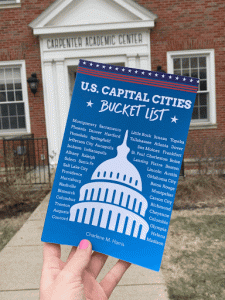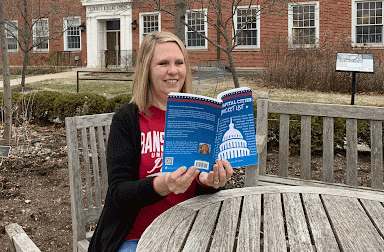If you’ve been inside Carpenter Academic Center, you have probably seen Charlene Harris. As the Humanities Administrative Assistant, Charlene works with professors and staff to ensure everything runs smoothly. On January 5th, she became the published author of an interactive travel guide titled U.S. Capital Cities Bucket List. The book gives readers places to see, eat, and explore in all 50 capital cities across the country, accompanied by journal pages to document their memories. I had the opportunity to talk with Charlene about the process of writing and publishing the book:
When did the idea of this project first come to you?
I had the good fortune of knowing a couple of authors in my town, and they made it seem doable and exciting. People were very interested and encouraged me to go on and make a book.
How long were you working on this book?
One of the interesting things is most people didn’t know I was working on a book because I never thought I’d complete it. The process began in 2020 when we were all locked down and were supposed to do creative things. I would pick it up and set it down and work on it a little bit all the time. But, again, I was never sure if I would completely finish the product.
So, you said you knew people who were authors and had some assistance with publishing and how that process works. What was the publishing experience like?
It was very eye-opening because there are a lot of steps and people involved, from editors to the final product with book layout and publishing to having the physical hard copy. And now I’m at the marketing stage, which is a whole new area to jump into. There are a lot of things that if you’re enjoying them, you can just spend hours and days on them.
 The format of the book invites you to write about your visits to city capitals. How did you decide on this layout?
The format of the book invites you to write about your visits to city capitals. How did you decide on this layout?
I went back and forth with people I knew who worked on bucket list-type books and other authors. They wrote books where it was a combination of a memory book, a journal, and an interactive book. This book starts with you reading it, but then you’re writing and recording your memories as you physically visit places. With the use of social media, everyone is supposed to communicate through tagging information. The book is a manual to go with having a good time and getting out and doing things. I feel like, not to dwell on COVID, but there was a point where we couldn’t fly and travel that way, so this was focused more on road trips. The combination of road trips, visiting with your kids, and trying to do affordable things that get you outside.
You wrote that your visits to state capitals began after you moved to Lexington. Would you be able to give us a Lexington bucket list?
I think with the location of Transylvania, there’s so much to see right downtown., Everyone knows Rupp Arena and UK, but the architecture of Gratz Park shows how our city was developed. The Mary Todd Lincoln House and Henry Clay Estate show how far back we go. There are so many things you could do.
A lot of students at Transy have goals of creating and sharing their work, especially through a physical medium. Having accomplished that yourself, what advice do you have to give?
I think one piece of advice would be not to be afraid to ask other people if you’re interested in something. Inquire as to how they got involved or if they would help you. Just be curious about everything, and it’s not like you have to completely commit, but gather as much knowledge and information as you can from someone because someday you may want to use that.
There is something really neat about having a physical book, even from being a reader. A book can be something that can showcase your work if you’re going for a job interview or something; it would really set you apart. I also feel like a book shows that you have an interest and you can inspire other people through that.
Anything else you would like to add?
I’ve been very pleased with how supportive and encouraging the faculty, staff, and people at Transylvania have been about this.



